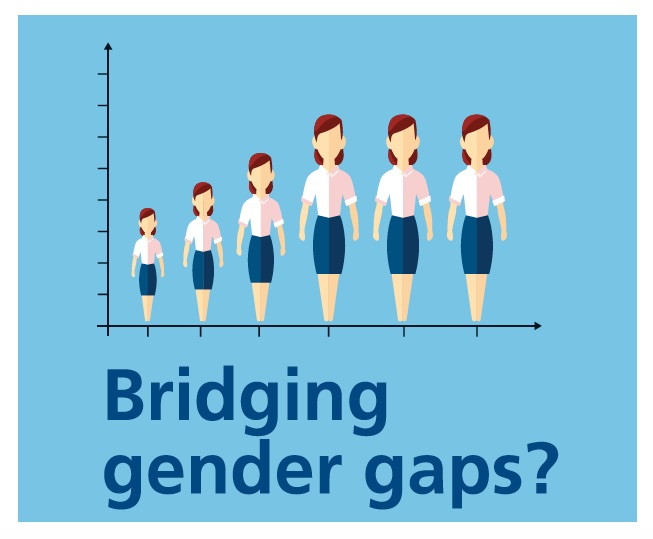The strong increase in female labor force participation is among the most salient of the socioeconomic changes that have taken place in Latin America in the last half-century, not only because the increase implies a profound transformation in the daily life of millions of Latin American women and families, but also because of its impact on the economy, poverty, inequality, unemployment, and education.
Despite these benefits, the long-run pattern of gains for women has been insufficient to close the gap with men in most labor market outcomes, such as wages, employment, and labor force participation.
In fact, the results of our study, available in our recently published book, “Bridging gender gaps? The rise and deceleration of female labor force participation in Latin America”, highlight a change in female labor force participation that makes the situation potentially more worrisome: there are signs of a widespread and significant deceleration in the entry of women into Latin American labor markets that seems to have been taking place since the early/mid-2000s. This deceleration applies to all women, but particularly to more vulnerable groups: women with low education, living in rural areas, with children, or married to low-earnings spouses.
 This deceleration of female labor force participation has delayed the closing of the gender gap. Moreover, this trend may also compromise poverty reduction targets.
This deceleration of female labor force participation has delayed the closing of the gender gap. Moreover, this trend may also compromise poverty reduction targets.
Although the evidence we discuss in the book is never conclusive and admits alternative explanations, our preferred interpretation is that the fast economic growth experienced by Latin America in the 2000s was an important determinant of this deceleration: with more jobs, greater social protection benefits, and with their partners earning higher wages, more and more women chose to stay home.
But if the cause of this trend is shared prosperity, why would it be bad news? In fact, the trend may have some positive implications, such as a potential for better job matching, and more time for higher quality parental childcare.
However, the problem is that being out of the labor market for some time may imply loss of productivity, and it may also reinforce traditional gender roles within the household. These factors may cause a reduction in the attachment to the labor force for women and, ultimately, reduce possibilities for autonomous income generation in the longer term. This may in turn hinder the process of poverty reduction in the region, in which women’s work played a crucial role in the last decades.
What can labor policies do?
The recent slowdown in female labor force participation is likely to place active labor policies at the center of the policy debate. In the book, we discuss a large set of policy interventions that may help foster female employment, and that can be classified according to three main objectives: relaxing constraints on women’s time, improving opportunities for women’s agency, and attaining fair labor markets. Examples of the main initiatives are listed below.
Childcare centers and pre-primary education should be expanded, and schools with extended hours and care services for the elderly should be promoted.
The system of parental leave should be extended and updated to include paternity leave that cannot be transferred to women, parental leave for childcare, more flexible schedules, and collective financing.
More information and resources for family planning should be made available so as to ease access to contraceptive methods and remove incentives for increased fertility.
Co-responsibility at home should be advocated as it may empower women and facilitate their advance into labor markets.
Gender equality in terms of property rights, for instance, should be advanced by improving the security and rights of cohabitating, widowed, and divorced women.
Governments should pay attention to the unintended effects of social programs on gender issues, and try to alleviate their potential side effects.
More flexible work arrangements could be useful for the dual objectives of caring for children and older adults at home while letting women pursue professional careers. However, such work arrangements have some drawbacks (e.g. reinforcing traditional gender roles within the family); this initiative therefore calls for a case-by-case evaluation.
Education should be extended to disadvantaged groups, including vulnerable women; this remains a central policy for labor force participation.
Some of these initiatives are already in place in Latin America, but others are still missing in the region.
* Leonardo Gasparini and Mariana Marchionni are the coauthors of the book “Bridging gender gaps? The rise and deceleration of female labor force participation in Latin America”, written in CEDLAS-Universidad Nacional de La Plata (Argentina), as part of the project “Enhancing Women’s Economic Empowerment Through Better Policies in Latin America,” a joint initiative with CIEDUR, that was carried out with the aid of a grant from the International Development Research Centre in Ottawa (Canada).
The views expressed in the book or in this post do not necessarily represent those of IDRC or its Board of Governors.
A previous version of this post was published by the Inter-American Development Bank on November 5th 2015.

